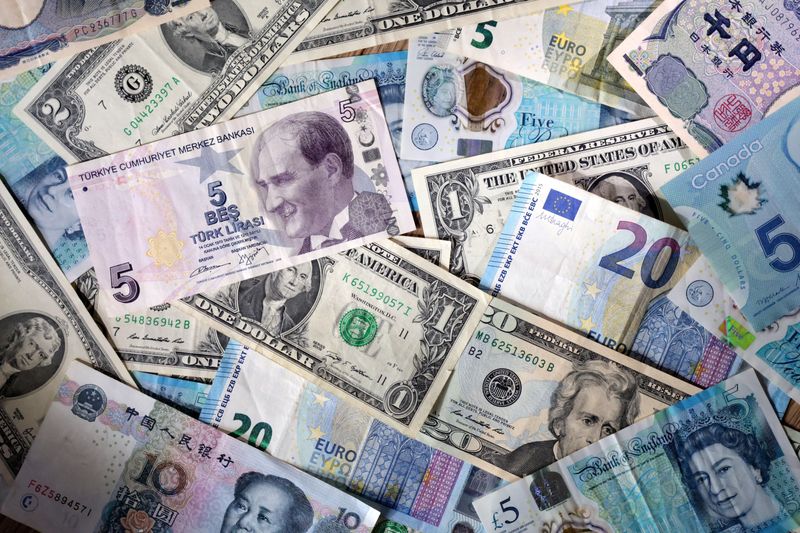Forex
Dollar slumps on recession fears; yen, Swiss franc benefit

Investing.com – The U.S. dollar fell sharply Monday on concerns over U.S. economic growth, with the Swiss franc and the Japanese yen seeing strong safe-haven demand.
At 08:45 ET (12:45 GMT), the Dollar Index, which tracks the greenback against a basket of six other currencies, traded 0.9% lower to 102.100, at its lowest level since near the start of this year.
Dollar weaker on recession fears
The dollar selling follows on data showing a sharp cooling in the U.S. jobs created in July on Friday, with U.S. Treasury yields dropping significantly as traders began factoring a hard landing for the U.S. economy from the prolonged period of elevated interest rates.
Traders now fully expect the U.S. to cut interest rates in September, and are looking for more substantial cuts than the around 50 basis points of reductions that had previously been priced in this year.
Wells Fargo, for instance, now projects two 50 basis-point rate cuts at the Federal Open Market Committee meetings in September and November.
This prediction marks a substantial shift from earlier forecasts due to emerging economic indicators, with recent data prompting worries about the economy.
“Importantly for the dollar, fears of a U.S. recession mean that the market is no longer looking for an orderly adjustment in Fed policy towards some kind of neutral rate – say near 3.25%.” said analysts at ING, in a note. “No, the fear of a recession is now bringing in the idea of stimulative monetary policy.”
Swiss franc in demand as carry trades unwind
In Europe, the Swiss franc soared as traders sought some form of safety during these turbulent times.
The franc climbed to a seven-month high against the dollar, with down 1.4% at 0.8458.
The Swiss currency also benefited from the unwinding of carry trades, where investors borrow in money from economies with low interest rates such as Japan or Switzerland to fund investments in higher-yielding assets elsewhere, which have been popular in recent years.
rose 0.6% to 1.0974, given the broadly weaker dollar.
Expectations for more cuts by the have also risen, but very few traders have been long euros since the start of the political turmoil in France at the end of June.
“Weaker global growth is not good for the pro-cyclical euro, but the fact that the ‘US exceptionalism’ narrative could be coming back to earth with a bump should be EUR/USD supportive – assuming that the Fed is prepared to cut rates sharply” ING added.
slipped 0.4% to 1.2752, amid fears that the may also be behind the curve with the U.K. central bank only having cut interest rates last week.
Even then the policymakers were split 5-4 on the decision to reduce rates by a quarter-point to 5%, suggesting that the central bank would still move cautiously going forward.
Yen surges to seven-month high
In Asia, slumped 3.2% to 141.86, with the yen surging to seven-month highs against the dollar as traders aggressively unwound carry trades in the expectations of substantial rate cuts from the Federal Reserve.
The rebound in the yen, which hit a 38-year low against the dollar in July, has also been helped by the Bank of Japan’s 15-basis points rate rise last week.
“It is hard to argue with USD/JPY extending this correction to the 140 area – which we had seen as the outside risk last week,” said ING.
fell 0.6% to 7.1167, with the yuan rallying given the U.S. dollar weakness even amid concerns over an economic slowdown in China.

 Forex3 years ago
Forex3 years agoForex Today: the dollar is gaining strength amid gloomy sentiment at the start of the Fed’s week

 Forex3 years ago
Forex3 years agoUnbiased review of Pocket Option broker

 Forex3 years ago
Forex3 years agoDollar to pound sterling exchange rate today: Pound plummeted to its lowest since 1985

 Forex3 years ago
Forex3 years agoHow is the Australian dollar doing today?

 Cryptocurrency3 years ago
Cryptocurrency3 years agoWhat happened in the crypto market – current events today

 World3 years ago
World3 years agoWhy are modern video games an art form?

 Commodities3 years ago
Commodities3 years agoCopper continues to fall in price on expectations of lower demand in China

 Economy3 years ago
Economy3 years agoCrude oil tankers double in price due to EU anti-Russian sanctions
























